Whether you accept it, avoid it or live somewhere in between, insurance coverage has become a defining issue for our profession. Patients increasingly expect to use their benefits, practitioners want to be compensated fairly for their time and expertise, and the system itself remains – at best – fragmented. The encouraging news is that coverage has expanded in meaningful ways. The challenging news is that reimbursement, across the board, remains inadequate.
A Sign of Serious Disease: Heating Up the Body With External Qi
When you contract a virus and have influenza, the internal temperature of your whole body can go up from the normal temperature of 98.6 F to around 101 F or more. The higher your temperature goes up, the worse you feel, and the more scared you are that it is a terrible disease.
I believe that the theory, "The higher the temperature, the more serious the disease," is a great rule of thumb in the various healing modalities of Chinese medicine. This is especially relevant now, because we can measure the local temperature of different parts of the body through infrared imaging.
Let us now begin by going deeper into the mechanism of heating up the body: Why does the body heat up in most cases and not cool down when it wants to fight a disease? One physiological reason is that the body realizes there is a foreign enemy, an antigen inside the body that needs to be eliminated. In order to fight the foreign invader, the body increases its biochemical reactions so that more ammunition (antibody) is created to eliminate or neutralize the antigen.
What happens if your disease is not influenza, which affects the whole body? What if your health problem is localized? For example, when you fall down and hurt your shoulder, the average temperature of your whole body is more or less the same, but your shoulder becomes hot because it is trying to repair itself by increasing biochemical reactions. This local heating of the shoulder shows up easily in infrared imaging, as shown in Figure 1. In this case, Patient A had dislocated his shoulders.
(Color code for infrared images is as follows: White is the hottest, then red, yellow, green and blue, with the coldest color in black.)

Figure 1: Cooling of the shoulder of Patient A by external qi. The maximum temperature of the chest in the front view as shown in Figure 1a was 95.29 F before healing, which was reduced to 94.75 F by an amount of 0.54 F after healing with external qi, as shown in Figure 1b.
As shown in Figure 1a and Figure 1b, before and after being healed with external qi, the temperature of the patient's shoulders dropped. The meaning of the decrease in the body surface temperature in the shoulder region was clear. The shoulder region was getting better from the healing. There was no need to maintain a high rate of biochemical reactions, less heat was released, and the surface temperature became cooler.
This is similar to the body recovering from influenza, when the temperature drops from 101 F to 98.6 F. The body does not need the high biochemical reactions to fight the virus once it has vanished after treatment.
For the majority of cases, the body surface of patients treated with external qi cools down as well. Biophysics Basis of Acupuncture and Health provides extensive documentation and infrared imaging of hot pain in different parts of the body, showing the cooling down of the area through the use of a needle. We observe the decrease of body temperature from a wide range of health problems, including recovery from influenza and pain relief, through the use of acupuncture.
Is there an increase of body temperature due to the healing by external qi? The answer is yes. There are a small number of cases where the body surface temperature actually increases. Does it necessarily mean that the patient is getting worse if there is an increase in body temperature? The answer is probably no. It just means that the patient has a serious health problem. With the help of external qi, the local problem area of the patient needs to increase the rate of biochemical reactions to fight the cause of sickness.
This fascinating phenomenon of the heating up of the body's surface temperature when patients are being healed by external qi requires more in-depth study because it may provide a way to detect serious health problems early on.
Three cases to illustrate this phenomenon are below:
Case One
Patient B came to us with many health problems. During his first visit, he was healed with non-touching external qi. As usual, we took infrared images of his face, chest and upper back before (Figure 2a, Figure 2c, Figure 2e) and after healing (Figure 2b, Figure 2d, Figure 2f). We found that there was a large increase in heated areas on the surface of the face, chest and neck area after treatment of external qi. Visually, we can see in Figure 2a and Figure 2b a large increase in the white areas (the hottest color in our color code) of the chest area before and after healing. When we asked the patient, he confirmed that he had chest pain and his father had a heart attack at the same age that he was now. He was happy that we found out that he might have a serious heart problem. To show that the heating up is genuine, we examined the surface temperature of his feet. There was no change, as shown in Figure 2e and Figure 2f.
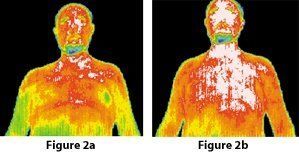

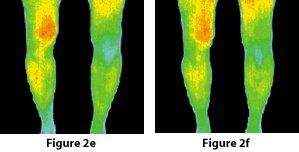
Figure 2: Temperature profiles of Patient B were shown before healing with external qi for the face in Figure 2a, the upper back in Figure 2c and the feet in Figure 2e. After healing with external qi, the temperature profiles for the face, upper back and feet were shown in Figure 2b, Figure 2d and Figure 2f. The maximum temperature for the face increased from 94.32 F before healing to 94.75 F after healing, by an amount of 0.54 F. The absolute amount of 0.54 F might not seem great, but the change in temperature was on a much larger surface, so the increase in temperature was considered significant. The maximum temperature for the neck increased from 93.5 F before healing to 94.64 F after healing, by an amount of 1.14 F. The white hot area in the neck region was tiny before healing, which increased to cover almost the complete neck. The maximum temperature of the legs stayed at 91.36 F before healing, to 91.25 F. The difference is only 0.11 F, which is within statistic fluctuation. If you look at the two pictures Figure 2e and Figure 2f, the color distribution almost looks identical.
Case Two
Patient C came to us with complaints that he was depressed, very tired and could not sleep properly. After he was healed with non-touched external qi, his whole body was heated, as shown in Figure 3. As it turned out, he had suffered from this problem for many years and it was getting worse. He had gone and studied 21 modalities of natural healing methods and was getting nowhere. After several healing sessions, he was getting better. With hindsight and the discovery of heavy metal in his live blood analysis, the patient and the healer felt that his sickness most likely came from mercury poisoning. When he was 8 or 9 years old, he played with mercury constantly with his fingers throughout his childhood.
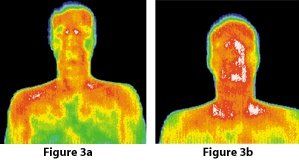
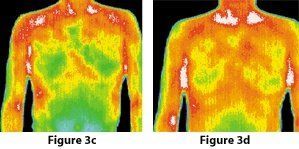
Figure 3: Temperature profiles of Patient C are shown before healing with external qi for the face in Figure 3a and the chest in Figure 3c. After healing, the temperature profiles for the face and the chest were shown in Figure 3b and Figure 3d. The maximum temperature for the face increased from 94.21 F before healing to 94.53 F after healing, by an amount of 0.32 F. The absolute amount of 0.32 F might not seem large, but the change in temperature was on a much larger surface, so the increase in temperature was considered significant. Similarly, the maximum temperature of the chest was increased from 94.32 F before healing to 94.64 F, by an amount of 0.32 F.
Case Three
At the urging of his wife, Patient D came to see me. His infrared imaging showed that his body surface temperature heated up after being healed with external qi. This was shown in Figure 4. It turned out that he had many problems including genital herpes, a liver problem, a pancreas problem and childhood emotional problems.
After treatment once a week for two months, he was getting better. Then his body surface temperature no longer increased after healing with external qi. In fact, the body surface temperature decreased after healing with external qi (Figure 4).



Figure 4: Temperature profiles for the face and the upper and lower back of Patient D before healing with external qi were shown in Figure 4a, Figure 4c and Figure 4e. After healing, they are shown in Figure 4b, Figure 4d and Figure 4f, for the patient's face and upper and lower back, respectively. The maximum temperatures of his face and upper and lower back increased from 93.69 F, 93.14 F and 92.67 F to 94.32 F, 94.53 F and 93.14 F, respectively. The increased amounts were 0.63 F, 1.39 F and 0.47 F, respectively. A visual inspection of the white areas, which indicated the highest temperature, showed a considerable increase, approximately more than five times, from healing with external qi. Hence, I considered that the heating up of the body's surface temperature was significant.


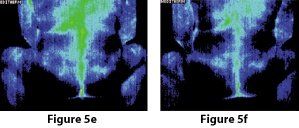
Figure 5: Temperature profiles for the face and the upper and lower back of Patient D three months later were shown before healing with external qi in Figure 5a, Figure 5c and Figure 5e. After healing, they were shown in Figure 5b, Figure 5d and Figure 5f for patient's face and upper and lower back, respectively. The maximum temperatures of his face and upper and lower back decreased from 93.73 F, 91.96 F and 89.59 F to 92.55 F, 91.36 F and 88.88 F, respectively. The decreased amounts were 1.18 F, 0.60 F and 0.71 F.
Besides the three cases cited above, I actually have seen quite a few cases in which the surface body temperature heated up after healing with external qi. My tentative explanation for the heating up of one part of the body from healing with external qi is that that part of the body needs help badly. It needs more biochemical reactions to restore health.
This interpretation is a generalization of our earlier thesis that there are two kinds of pain: hot and cold. The cold pain, which is defined as being colder than normal, as seen in infrared images, generally comes from old causes and is much harder to treat. Cold pain is a more serious pain. A proper treatment with acupuncture is tonification, which will induce the warming of that cold pain area. This agrees with my rule of thumb that cold pain is a more serious health problem. I conclude the heating up of a certain part of the body's surface temperature from a proper treatment might be regarded as the symptom of a serious disease.



